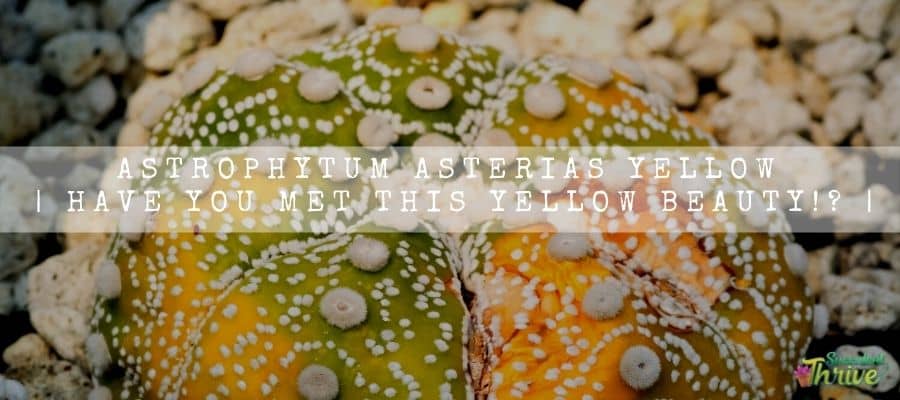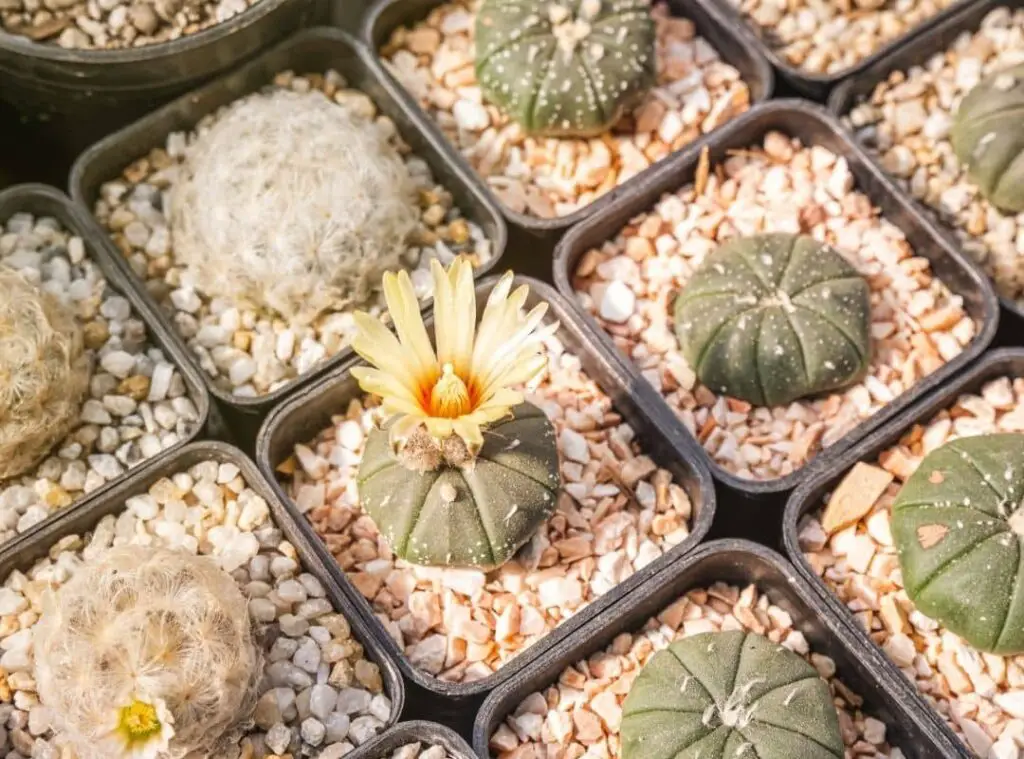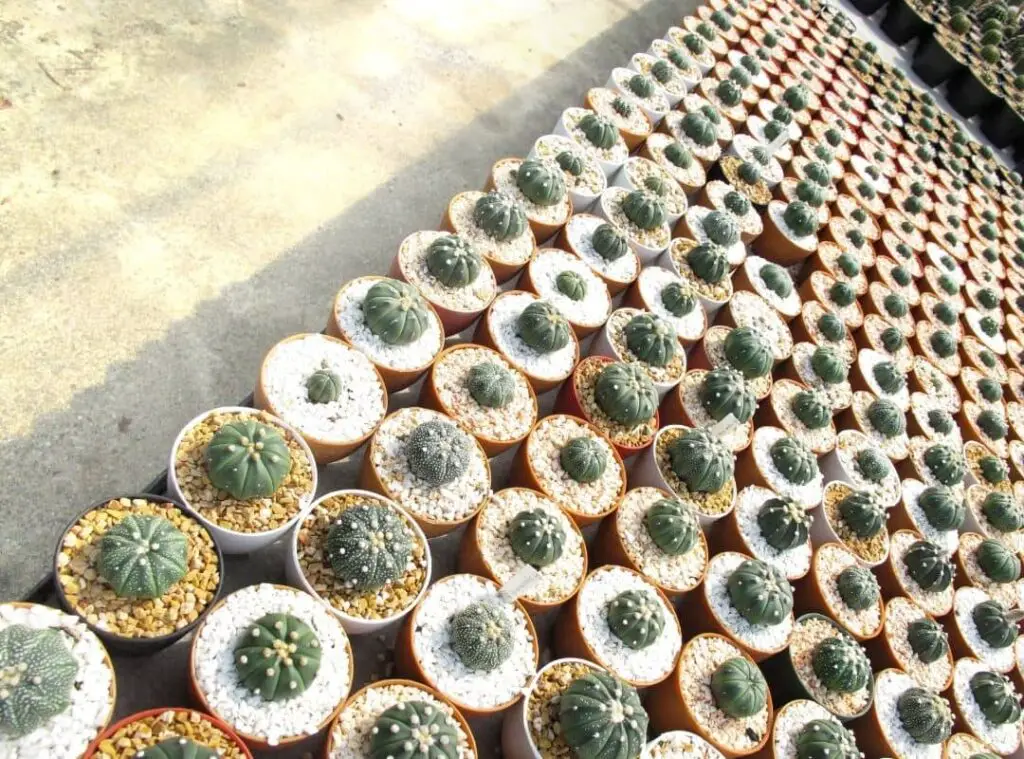Mexico is the home of the lovely and unusual Astrophytum Asterias Yellow cactus species. It may provide a lot of personality to your garden with its vivid yellow spines and unique shape. But taking care of these cacti can be a little difficult, especially if you are new gardening.

I can speak from experience when I say that caring for Astrophytum Asterias Yellow plants can be challenging. I’ve had them in my garden for years. For them to thrive, certain needs and demands must be satisfied.
The fundamentals of Astrophytum Asterias Yellow care, including how to water, fertilize, and safeguard these cacti from pests and illnesses, will be covered in this article. You are able to successfully cultivate and take care of these lovely plants in your own garden with a little bit of knowledge and work.
One look care guide
| Botanical Name | Astrophytum asterias yellow |
| Common Name | Star cactus Sand dollar cactus Sea urchin cactus Star peyote |
| Plant Type | Cactus |
| Mature Size | 7 cm (3 inches) height 15 cm (6 inches) widespread |
| Sun Exposure | Partial shade |
| Soil Type | Well-draining |
| Soil pH | neutral to slightly alkaline |
| Bloom Time | from March to May |
| Flower Color | Yellow |
| Hardiness Zones | USDA hardiness zones 8 to 9. |
| Native Area | Mexico , USA |
| Toxicity | Non toxic |
| Average price | 7USD |
How do I identify astrophytum asterias yellow
Astrophytum asterias yellow could contain about 5–8 ribs, which you may spot in brown to green or in green only. When they grow in their natural habitat, they grow flat, and you can spot them almost flushed, particularly during hot and arid weather conditions.
Their stems are triangular shaped, and the ribs consist of white areolas, which have small white tufts.
They would reach a maximum height of 7 cm (3 inches). Further, their maximum width would be about 15 cm (6 inches). When you grow them as houseplants, they will tend to take a round shape. Astrophytum asterias yellow produces flowers from March to May, and they would be yellow in color. Those blooms would take the shape of a funnel and would have orange centers.
They would usually arise at the top of the plants. This is one of the significant factors which you may use to identify the Astrophytum asterias yellow plants.
Moreover, they would produce a fruit of a reddish-pink color as well. They would be oval-shaped and would also comprise fuzzy hairs. They will replace the flowers on the plants. You may probably get confused in identifying the Astrophytum asterias with Lophophora williamsii plants.
Lophophora williamsii vs. Astrophytum asterias
In his PhD thesis, plant scientist Terry explained how to easily distinguish between these two plants.
Peyote, also known as Lophophora williamsii, mimics star cactus in terms of size, shape, and lack of spines. Peyote, in contrast, lacks the minuscule whitish epidermal scales present on star cactus and is bluish-green in color. The number of ribs on Peyote ranges from 5 to 13, with the number rising with size and maturity.
In comparison, a star cactus typically has 8 ribs throughout its entire life. In contrast to star cactus, peyote’s ribs may extend in a spiral configuration toward the base. Unlike star cactus, mature specimens of peyote may have prominent tubercles that give the ribs an uneven look. South Texas peyote blooms are pale pink to nearly white in appearance, whereas star cactus blossoms are vivid yellow with a crimson throat.
Size of the plant
Astrophytum asterias yellow plants would reach a maximum height of 7 cm (3 inches). Further they would be about 15 cm (6 inches) widespread.
Growth rate
Astrophytum asterias yellow is a slow-growing plant with growth patterns similar to other plants.
How do you take care of Astrophytum asterias yellow?
Light Requirement
Astrophytum asterias yellow can survive in low light conditions. This is somewhat different from other species, as Astrophytum asterias color would be intensified given that they get partial shade. If you grow them as houseplants and believe they aren’t getting enough sunlight, you could place artificial lights, such as grow lights, closer to the plants. Grow lights would be quite handy in this circumstance.
Temperature and humidity
Succulents and cactus in general are fond of growing in warmer temperatures, and Astrophytum asterias yellow has the same requirements when it comes to temperature levels. They could withstand temperatures around 70 degrees Fahrenheit (21 degrees Celsius) during the summer. On the other hand, when the temperature decreases, you do not need to bring them indoors, as these are cold hardy plants.
They are tolerant of temperatures around 20 degrees Fahrenheit ( -6.6 degrees Celsius). However, if you expect further reduced temperature levels, it would be safer to bring them indoors.
In terms of the humidity levels, they would grow well in room humidity levels. In case there is a high humidity level, you may be tactful in locating dehumidifiers closer to your plants. Alternatively, you may use air vents as well.
Is it cold hardy?
Astrophytum asterias yellow are somewhat cold hardy plants.

Flowering
Astrophytum asterias yellow can produce flowers if given a restful winter period. In order to do that, you need to water them less frequently and relocate the cactus to a much cooler place during the winter months. If you adhere to these tips, it will stimulate the flowering of the plants.
They would usually flower from March to May. Astrophytum asterias yellow blooms would be yellow. Further they will comprise of centers in orange as well.
In terms of the diameter, it would be about 3 inches. Once they finish blooming, they will transform into a fruit. You could spot them in pink, red or in gray. They will be hairy too.
USDA Hardiness Zone
Astrophytum asterias yellow prefer to grow in USDA hardiness zones 8 to 9.
Watering Requirement
When it comes to watering, Astrophytum asterias yellow is somewhat contradictory, as they prefer to have plenty of moisture on occasion. Cacti, and Astrophytum asterias yellow in particular, appear to have evolved to thrive in hot, dry environments. Apparently, it is not! They will prefer to have a lot of moisture.
However, at the same time make sure that you allow the soil to become dry between two watering sessions also. When watering, ensure that you water them thoroughly and deeply.
In terms of watering frequency, they will generally survive with once-a-month watering. Consider watering them more often if you live in much warmer conditions. No matter what, ensure that you do not leave the roots in waterlogged conditions. If you do this, you risk causing root rot and other serious damage to the plant’s health. You may cut back on watering them during winter so that they will not drown.
Soil Requirement Type / pH
You may proceed with any type of soil mix to grow these plants, given that they have excellent drainage. When they grow in their natural habitat, they grow in rocky areas where there is clay or loam soil available.
In terms of the right ph. of the soil mix, they will prefer to have a neutral to slightly alkaline potting medium.
You may find potting mediums which are specifically designed for succulents and for cactus. They would perfectly suit these plants.
Pot size Potting and Repotting
You could consider using a clay pot or a terracotta pot to grow them, as these are all porous materials that would be beneficial for the plant’s growth. Further, you could do it only if it is essential. Ideally, you could go ahead with that during their active growth phase, which could possibly be in the month of June.
Furthermore, you may consider repotting them when you spot them outgrown from their posts as well.
Moreover, when transplanting them, ensure that you use a pot that is slightly larger than the previous one. Once you obtain the pot, you need to fill it with a fresh, well-draining soil mix. Do not overwater or overfeed the repotted plants, as it could be harmful.
Where to Plant
Plant them in a soil mix which is well-draining. Furthermore, you need to select a place where they can receive adequate sunlight levels as well.
Fertilizer and time of year
Astrophytum asterias yellow does not require regular feeding. I recommend using a balanced all purpose 20-20-20 fertilizer when feeding them. However, before you use it, make sure that it is diluted, and only then apply.

Dormancy
Astrophytum asterias yellow could go dormant during extreme winter conditions. During their dormancy, ensure that you keep them dry.
Toxicity
Astrophytum asterias are nontoxic plants.
Common bugs and illnesses
Root rot
Overwatering may result in root rot of the Astrophytum asterias plants. Literally if you leave the soil to become wet and if you do not use a well-draining soil mix, they could be the root causes for this condition.
It is somewhat difficult to identify root rot well in advance. With that being said, if you spot your Astrophytum asterias plant’s upper part turning yellow and mushy, it is an indication to let you know that the plant is suffering from root rot. In addition to that, your plants may be stinking too.
When treating them, first take the plant out from the pot. After that, knock away the older soil around the plant’s roots. If you come across any rotten or black root parts, you need to immediately cut them off.
When cutting them, ensure that you are using all sharp, sterile scissors or knives for this purpose. After that leave them in a hot and a dry place where they can develop callousness. Finally, you may plant them in a fresh pot. Consider watering them less often.
Mealybugs
You may come across mealybugs particularly between their ridges. They usually form a white cottony mass on the plant’s surface and are dependent on the Astrophytum asterias plants sap.
To treat them, you may use a household insect spray, neem oil. Alternatively, you could use detergent or soapy water to rinse them off. You may continue doing it until you eliminate the infestation.
Scales
These are parasite pests types and they will depend on the plant’s sap. When scales invade the Astrophytum asterias plants, they will look sick and become wilted too. You may use a diluted detergent or soapy water to treat them.
Special Care tips
Astrophytum asterias could be maintained very easily. However, I encourage you to get rid of the older blooms so that it will look pleasant. Above all, they could be perfect breeding places for pests
How to propagate astrophytum asterias yellow
You may use the Astrophytum asterias seeds to propagate them. You could find the seeds in their flowers. You need to remove them from the dried flowers and plant them as regular seeds. This is the simplest method of propagation, and even a novice gardener can try it.
Astrophytum asterias seeds are so fragile. Hence deal with them carefully. Furthermore, once you harvest them, you need to dig them in a well-draining soil mix immediately as they have a short life. Further there will be less chance to form roots as well.
Ideally, you need to place them in a tray or in a container that is filled with a fresh cactus soil mix. Next, cover them with some potting soil. Cover them with plastic wrap so that the humidity and heat stay inside. Once the germination is complete, you may leave the specimen in a sunny, warm place. However, do it gradually. You may plant the new baby plants after a few weeks’ time. You may continue with regular care afterwards.
According to two plant scientists ( Anna W. Strong and Paula S. Williamson ) this star cactus need pollinators to produce new generation of plants. A pollinator is therefore necessary for successful reproduction. Given that hand-pollinated flowers produced less fruit and seeds than open-pollinated flowers, it is possible that A. asterias is limited in its ability to reproduce due to the scarcity of pollinators.
Conclusion
Anyone would love growing Astrophytum asterias. Propagating them would be even more interesting. They are so fabulous in their looks that anyone would want to have them. Astrophytum asterias can be grown by anyone, whether they are beginners or experienced gardeners. All you need to assure them of is that you provide them with ample moisture levels, a well-draining soil mix, and sufficient levels of heat and light.
Astrophytum asterias would be wonderful additions to your garden. One more benefit of having these plants is their ability to produce fantastic flowers. Apart from that, because of their unique characteristics, they can be used as gift items. Happy gardening with Astrophytum asterias !
References
Terry, M.K., 2007. A tale of two cacti: studies in Astrophytum asterias and Lophophora williamsii (Doctoral dissertation, Texas A&M University).
Strong, A.W. and Williamson, P.S., 2007. Breeding system of Astrophytum asterias: an endangered cactus. The Southwestern Naturalist, 52(3), pp.341-346.
Read Next : Euphorbia Lactea Variegata Care | A Few Essential Steps |
